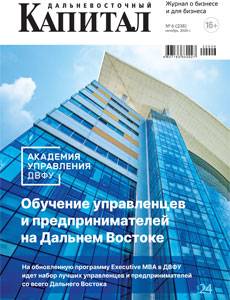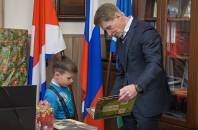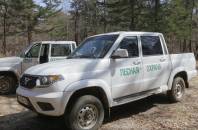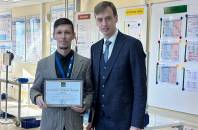|
Региональный журнал для деловых кругов Дальнего Востока
|
|
||||||||||||||||||||||
|
Пятница| 09 Января, 23:07 |
|
|
Тема номера
|
|||||||||||||||||||||

 Олег Кожемяко осуществил новогодние желания маленьких приморцев
В преддверии новогодних праздников заветные желания маленьких приморцев начинают сбываться. Так, Губернатор Приморского края Олег Кожемяко передал подарки от Деда Мороза двум маленьким приморцам: шестилетнему Мирону Глушаку из Тернейского муниципального округа и четырёхлетней Ольге Алимпиевой из Арсеньева.
Олег Кожемяко осуществил новогодние желания маленьких приморцев
В преддверии новогодних праздников заветные желания маленьких приморцев начинают сбываться. Так, Губернатор Приморского края Олег Кожемяко передал подарки от Деда Мороза двум маленьким приморцам: шестилетнему Мирону Глушаку из Тернейского муниципального округа и четырёхлетней Ольге Алимпиевой из Арсеньева.
 Родители ребят с ОВЗ обсудили вопросы образования и трудоустройства с представителями власти Приморья
Третья встреча клуба "На равных", призванного помогать гражданам решить непростые жизненные ситуации, состоялась в Приморье. В этот день участниками клуба стали родители детей с инвалидностью и ограниченными возможностями здоровья. Они обсудили с представителями власти вопросы образования и трудоустройства таких ребят.
Родители ребят с ОВЗ обсудили вопросы образования и трудоустройства с представителями власти Приморья
Третья встреча клуба "На равных", призванного помогать гражданам решить непростые жизненные ситуации, состоялась в Приморье. В этот день участниками клуба стали родители детей с инвалидностью и ограниченными возможностями здоровья. Они обсудили с представителями власти вопросы образования и трудоустройства таких ребят.
 Социальные предприниматели Приморья могут найти кадры и получить рекламу на радио при господдержке
Открыт прием заявок на две актуальные для социальных предпринимателей меры поддержки: "Размещение двух вакансий на HeadHunter" и "Размещение рекламы на радиостанции". Такой формат господдержки поможет социальному бизнесу Приморья продвигать свои услуги в осенний период и найти профессиональные кадры для расширения штата.
Социальные предприниматели Приморья могут найти кадры и получить рекламу на радио при господдержке
Открыт прием заявок на две актуальные для социальных предпринимателей меры поддержки: "Размещение двух вакансий на HeadHunter" и "Размещение рекламы на радиостанции". Такой формат господдержки поможет социальному бизнесу Приморья продвигать свои услуги в осенний период и найти профессиональные кадры для расширения штата.
 24 протокола составили на нарушителей противопожарного режима в приморских лесах
Лесничие и инспекторы в Приморье составили 24 протокола в отношении нарушителей особого противопожарного режима на землях лесного фонда. ОПР действует в большинстве муниципалитетов и подразумевает крупные штрафы за пренебрежение правилами пожарной безопасности.
24 протокола составили на нарушителей противопожарного режима в приморских лесах
Лесничие и инспекторы в Приморье составили 24 протокола в отношении нарушителей особого противопожарного режима на землях лесного фонда. ОПР действует в большинстве муниципалитетов и подразумевает крупные штрафы за пренебрежение правилами пожарной безопасности.
Staying ahead of demand
In 2011 almost half of the country trade turnover (48%) accrued to the European Union, economies of Asia-Pacific Economic Cooperation or Asian-Pacific Region rank second with 24%. According to Russian Transportation Ministry estimates, the RFE’s cargo base may increase by 60% to over 200 million metric tons by 2020.
Railroads and seaports are the core components of the RFE transportation system, accounting for the majority of freight handled in the region. Other key components include roads, airways and domestic waterways. The share of the latter three modes is significantly smaller, but they are still essential for the economic development of remote areas lacking railroad access.
Russia’s Deputy Minister for Economic Development Alexei Likhachev noted in his assessment of the region’s accessibility by commercial transportation in the context of Russia’s international trade that emerging markets, notably India and China, will soon become the key engines of global economic growth. These economies could account for about 25% of Gross Global Product (GGP) by 2020 and about 33% by 2030. According to these forecasts, cargo volumes at RFE seaports could expand by 30% by 2020 and double by 2030. Among the key objectives for transportation infrastructure development to accommodate export growth Likhachev lists elimination of bottlenecks; infrastructure development to match future changes in cargo flows; and special emphasis on railway access links to port terminals.
“Russia’s decision to develop the transportation infrastructure of its eastern regions is a decision to compete with its neighbors. This means that in addition to forecasting the amounts and approaches to raising investment capital, we must also ensure that our entire transportation route remains competitive. To achieve this, the crucial task is to optimize the economics and efficiency of every port, including cargo unloading speed, the time a vessel spends in port, and so forth,” the deputy minister noted.
Transportation system development requires investment
Mainline railroads currently carry more than 80% of eastbound cargo flow and backhaul. According to national carrier Russian Railways, the Transsiberian Railroad handles up to 95 million metric tons of cargo and the Baikal-Amur Mainline (BAM) 12-20 million tons. Over 75% of all railroad cargo goes to or from the main ports in the Khabarovsk and Primorsky regions. The Vostochny, Nakhodka, Vladivostok, Vanino and De-Kastri ports are the key components of their respective railroad and maritime shipping transportation systems. The Vanino-Kholmsk ferry transports more than 90% of the cargo moving between Sakhalin Island and the mainland via the railroad/sea shipping system.
Cargo volumes carried on the BAM through the Komsomolsk railroad hub are projected to increase by 230% by 2015 and almost 350% by 2020; cargo flows are expected to expand by 200%-300% at the Vanino-Sovgavan transportation hub. In the Primorsky Region, the total annual amount of cargo handled by ports is expected to exceed 91 million tons for all cargo types by 2015 and over 100 million tons by 2020. According to Russian Railways CEO Vladimir Yakunin, this growth will necessitate a substantial upgrade to the Transsiberian Railroad and higher throughput capacity for the eastern portion of the BAM.
Throughput capacity expansion at RFE ports, where private interests are key investors, is proceeding more rapidly than railroad infrastructure growth. Major Russian coal producer SUEK is investing heavily in Khabarovsk Region ports, while the largest private investors in Primorsky Region ports are coal and steel producers Mechel and Evraz. According to the Russian Transportation Ministry, there are plans to increase the cargo-handling capacity of Posiet Port (a Mechel project) and Vostochny Port (a joint project of Vostochny Port, Ziyavudin Magomedov’s Summa Group, and Vostochny Stevedoring Company), as well as plans to complete construction of Stage 2 of an oil terminal at Kozmino Port, build a new coal terminal in Peter the Great Bay (Primorsky Region) and finish construction of a coal terminal in Muchka Bay, (Khabarovsk Region) and two coal terminals on Sakhalin Island: one near Izylmetyev Point and one in Kholmsk.
Sources of investment
RFE port expansion is proceeding apace, but construction and upgrades of railroad infrastructure in the region requires additional investment.
The development of RFE transportation infrastructure follows the guidelines set forth in the following strategy documents: RFE and Baikal Region Social and Economic Development Strategy through 2025; Siberia Social and Economic Development Strategy through 2020; Transportation Strategy through 2030, and others. Implementation of these strategies is financed from the federal government’s targeted allocation programs Social and Economic Development of the Russian Far East and the Transbaikal Region through 2013 and Russian Transportation System Development through 2015.
The Russian government’s federal Investment Fund has started financing projects in the RFE, such as the nearly completed Kuznetsov Tunnel on the BAM between Komsomolsk-on-Amur and Sovgavan. Private-sector companies are also investing in railroad infrastructure. Mechel, for example, is finishing construction of a 300-kilometer railroad connecting Ulag with the Elga Coal Field in Sakha (Yakutia).
Recent refinements of the RFE cargo base growth strategy suggest that previously earmarked budgets may have been grossly inadequate. The priorities of the Russian railroad infrastructure development program were defined in 2008 when the government approved the strategy for railroad transportation development through 2030. The subsequent years of recovery from the global economic crisis necessitated an upward revision: while total railroad cargo flows declined, eastbound flows were steadily growing, reflecting dramatic changes in world markets. In response, the government introduced a new, more front-loaded railroad development plan, covering the period through 2020.
“We estimate the required amount of investment in development through 2020 at RUB 181 billion for the Transsiberian Railroad and RUB 737 billion for the BAM,” says Vladimir Yakunin. “At Russian Railroads, we plan to invest RUB 15 billion per annum in the development of these routes even before any financing decisions are made by the government.”
Investment surcharges on railroad freight may be introduced as additional source of finance, and priority transportation rights may be offered to shippers who co-finance railroad projects. It has also been proposed that concession agreements be used in the railroad sector, as Russian law does not allow private investment in general-use public infrastructure. One idea being discussed is a plan for the government to buy Russian Railways’ infrastructure bonds.
Combining the most important airports
Opinions are also changing with regard to the development of RFE airport infrastructure. Konstantin Basyuk, who chairs Khabarovsk Airports board of directors, believes it advisable to establish an RFE airport holding company combining the assets of key airports in Khabarovsk, Yuzhno-Sakhalinsk, Petropavlovsk-Kamchatsky and Magadan. Khabarovsk Airport could become the leader of this consolidation, with the support of its strategic partner and shareholder since 2011 - South Korea’s Incheon International Airport Corporation, the manager of Incheon International Airport, which has been ranked the best airport in the world by passenger service quality for the past seven years in a row.
Khabarovsk Airport is the largest privately-owned airport in the Far Eastern Federal District. It handled 1.6 million passengers in 2011 and expects a 20% year-on-year increase in 2012 to 1.85 million. Total private investment in upgrading Khabarovsk Airport is projected at RUB 8 billion through 2020, with the project organized as a private-public partnership. Khabarovsk Airport invested RUB 650 million in the construction of a new cargo terminal for Vladivostok International Airport, where it is a shareholder.
Vladivostok International Airport has been substantially revamped, with a new runway built under the federal program to develop Vladivostok as an international cooperation center. Vladivostok International Airport is now rated by the ICAO to accommodate aircraft of all types.
Modern infrastructure has been built at the airport, with an apron for 23 aircraft, including 12 wide-body airliners. There is also a new passenger terminal complex and an express rail link. The new Vladivostok International Airport passenger terminal will be able to process 1,360 passengers per hour, or 3.5 million per annum.
Netherlands Airport Consultants B.V. has provided a master plan for Vladivostok International Airport development through 2030. The strategy envisages creating a hub to comfortably connect international and domestic flights, thereby accommodating the projected increase in passenger flow to 10 million per annum by 2030.
Last November, the Russian Transportation Ministry decided to lift restrictions on international carriers’ flights to Vladivostok International Airport, including Fifth Freedom of the Air flights between Vladivostok and airports in countries other than the airlines’ home nations.
New roads to rely on road use tax revenue
The Russian government’s road financing program is expected to proceed as currently planned, mainly targeting construction and upgrading of key roads likely to have a strong multiplier effect on RFE development. These include the Lidoga-Vanino and Nikolaevsk-on-Amur roads in Khabarovsk Region; Yuzhno-Sakhalinsk-Sakha in Sakhalin Region- Petropavlovsk-Kamchatsky-Klyuchi-Ust-Kamchatsk in Kamchatka Region; Palatka-Kulu in Magadan Region; Birobidzhan-Leninskoye in the Jewish Autonomous Region; and Kolyma-Anadyr in the Chukotka Autonomous Region. Regional road tax funds would serve as an additional source of finance for local road construction and maintenance.
By Nadezhda Vorontsova
 #ПозывнойКультура: Дед Мороз поздравил участников СВО в госпитале ТОФ с наступающим Новым годом
В преддверии Нового года агитбригада #ПозывнойКультура побывала в госпитале Тихоокеанского флота в субботу, 28 декабря. Для участников СВО, находящихся на лечении и реабилитации, прозвучали музыкальные поздравления. Со словами самых теплых пожеланий подарки военнослужащим вручила заместитель Председателя Правительства Приморского края – министр культуры и архивного дела Елена Бронникова.
#ПозывнойКультура: Дед Мороз поздравил участников СВО в госпитале ТОФ с наступающим Новым годом
В преддверии Нового года агитбригада #ПозывнойКультура побывала в госпитале Тихоокеанского флота в субботу, 28 декабря. Для участников СВО, находящихся на лечении и реабилитации, прозвучали музыкальные поздравления. Со словами самых теплых пожеланий подарки военнослужащим вручила заместитель Председателя Правительства Приморского края – министр культуры и архивного дела Елена Бронникова.
 Губернатор Приморья оценил оснащение Индустриального колледжа в Арсеньеве
Очередной день работы Губернатора Приморского края Олега Кожемяко в муниципалитетах региона начался с посещения Приморского индустриального колледжа в Арсеньеве. Глава региона изучил новое оборудование, на котором готовят специалистов технических специальностей.
Губернатор Приморья оценил оснащение Индустриального колледжа в Арсеньеве
Очередной день работы Губернатора Приморского края Олега Кожемяко в муниципалитетах региона начался с посещения Приморского индустриального колледжа в Арсеньеве. Глава региона изучил новое оборудование, на котором готовят специалистов технических специальностей.
 Комплекты быстровозводимых мостов начали поставлять в Приморье
Началась поставка средних автодорожных разборных мостов (САРМ) для проведения аварийно-восстановительных работ на дорогах Приморья. Всего на следующий год закуплено 11 комплектов. При необходимости комплекты САРМ будут использованы для оперативного восстановления проездов во время паводков.
Комплекты быстровозводимых мостов начали поставлять в Приморье
Началась поставка средних автодорожных разборных мостов (САРМ) для проведения аварийно-восстановительных работ на дорогах Приморья. Всего на следующий год закуплено 11 комплектов. При необходимости комплекты САРМ будут использованы для оперативного восстановления проездов во время паводков.
 Почти 900 сотрудников предприятий Приморья уже владеют бережливыми технологиями благодаря нацпроекту "Производительность труда"
Итоги реализации национального проекта "Производительность труда" и планы на будущее озвучил министр экономического развития Приморья Андрей Блохин на награждении команды Регионального центра компетенций. За четыре года работы нацпроекта реализовано 78 проектов по внедрению бережливых технологий на предприятиях края.
Почти 900 сотрудников предприятий Приморья уже владеют бережливыми технологиями благодаря нацпроекту "Производительность труда"
Итоги реализации национального проекта "Производительность труда" и планы на будущее озвучил министр экономического развития Приморья Андрей Блохин на награждении команды Регионального центра компетенций. За четыре года работы нацпроекта реализовано 78 проектов по внедрению бережливых технологий на предприятиях края.


